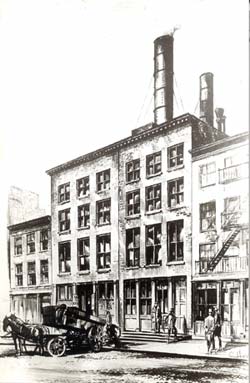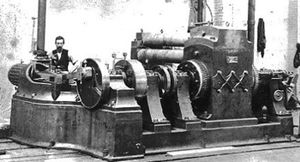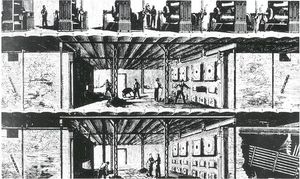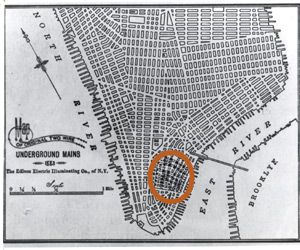Milestones:Pearl Street Station, 1882
The Pearl Street Generating Station, 1882
Thomas Alva Edison established the Edison Electric Illuminating Company of New York, now Consolidated Edison, to commercialize his 1879 incandescent lamp invention. On 4 September 1882, Edison’s direct current (dc) generating station at 257 Pearl Street, began supplying electricity to customers in the First District, a one-quarter square mile (0.65 square km) area. This installation was the forerunner of all central electric generating stations.
The milestone plaque may be viewed at the ConEdison headquarters building at 4 Irving Place, New York, NY.
For most of the 19th century, inventors in Europe and in North America worked to bring about electrical lighting. Electric arc lighting was first demonstrated in 1808 by Sir Humphry Davy, the British chemist and physicist. Arc lighting, with its open electric arc leaping between two carbon electrodes, the frequent need to renew the carbon tips, and brilliant and glaring light, was best suited to outdoor use or for very large indoor spaces. While arc lighting achieved commercial acceptance on both sides of the Atlantic Ocean by the 1870s, it was recognized early in the 1800s that incandescent electric lighting would be needed for homes and for most other indoor applications. Thomas Alva Edison, working at his laboratory in Menlo Park, New Jersey, turned his attention to electric light in mid-1878, a relative late-comer in the quest for practical incandescent lighting. By that time, many inventors and experimenters had contributed to the development of dynamos, devices for maintaining constant voltage, lamp technology, and other individual components needed to provide incandescent electric light.
The story of Edison's development of the first practical incandescent light in October 1879 after thousands of experiments with filament materials has been often told and is well known. From the outset, Edison realized that he would have to develop an entire system to generate, deliver, and utilize electric energy. Building on the work of other inventors in some cases and drawing on his own vision and ingenuity, Edison and his associates developed a parallel circuit to use his high-resistance filament lamp, an improved constant voltage dynamo to provide power to the parallel circuit, junction boxes and other components of an underground conduit system, safety fuses and insulating materials, and the necessary consumption meter, light fixtures, and switches. Edison then set up companies to manufacture most of the needed equipment and components.
Having invented and created an entire incandescent lighting system, Edison's task as an entrepreneur and industrialist was to demonstrate his low-voltage direct current (dc) system to the public. Edison's first commercial installation on land was at the printing firm of Hinds, Ketcham & Company in New York City. This installation went into service in January 1881 and, like other small, isolated systems subsequently installed by Edison, served one customer from a dynamo in the basement of the building. Having patterned his incandescent lighting system on then long-established and economical gas lighting systems, Edison's plan was to combine a central power station with a system of conductors to distribute electricity to the end users. He proved the technical feasibility of the central station concept with an installation under the Holborn Viaduct in London, United Kingdom, that operated successfully for about two years beginning in January 1882.
Shortly after announcing his intended development of a practical incandescent lamp in late 1878, Edison began to lay out his vision of a full-scale central station system for installation in New York City to conclusively prove that his dc system worked and was commercially viable. The result was the legendary Pearl Street station, the first permanent central power station for supplying incandescent lighting. The Beginning of dc Electric Service: Pearl Street, 1882 Edison carefully chose the service area and location for his first full-scale central station after conducting extensive market research. He wanted a densely populated area having a mix of commercial and residential uses. He also well understood the value of newspaper publicity and the need to impress and interest his present and potential financial backers. The area selected, known as the First District, was a rectangular area bounded by Wall Street on the south, by Nassau Street on the west, by the East River on the east, and by Spruce Street and the former Ferry Street on the north. The First District included much of the high-profile downtown business district, the financial capital of the United States. It was also home to the city's influential newspapers, including the New York Times. Edison formed the Edison Electric Illuminating Company of New York, a direct predecessor of the present Consolidated Edison Company of New York (Con Edison) in December 1880 to undertake the project. In April 1881, he secured a franchise from the New York City Board of Aldermen to install electric conduits and wires in the public streets. Edison purchased adjoining buildings at 255 and 257 Pearl Street, just south of the intersection of Pearl and Fulton Streets, for the Pearl Street generating station. Each building measured 25 ft by 100 ft and had four floors. He strengthened the structure of 257 Pearl Street to carry the weight of the dynamos and other heavy equipment on the upper floors, while 255 Pearl Street was held in reserve for possible future expansion of the station.
To supply electric power to the lights within Pearl Street's service area, Edison and his team developed the 27-ton "Jumbo" constant-voltage dynamo, named for a circus elephant then owned by P.T. Barnum. This dynamo was adapted from an earlier design by Werner Siemens in Germany. Each of the six dynamos installed at Pearl Street had a capacity of about 100 kW and could supply about 1,200 lamps. The six dynamos were driven by Armington & Sims reciprocating steam engines supplied by four coal-fired boilers.
The project involved the installation of about 80,000 ft of underground conductors in a manhole and conduit configuration. The original system consisted of two wires in the form of twin half moon shaped copper conductors, separated within the conduit by rope and insulated with beeswax, linseed oil, and asphaltum. The original system operated at 110 V dc. Because of the large amount of costly copper (the main and feeder distribution system was the most expensive component of the entire project) required, Edison quickly supplanted the two-wire configuration with a 220-V, three-wire design that greatly reduced the amount of copper needed for the conductors. This resulted in a significant cost saving.
Edison served as his own chief engineer on all phases of the design and construction of the project. The Pearl Street station was finally completed and put into 2 commercial operation on the afternoon of 4 September 1882. Edison was standing in the office of J. Pierpont Morgan of Drexel, Morgan & Company, one of his principal investors, when he gave the signal to John W. Lieb, chief electrician, to close the switch to start delivering dc power to customers in the First District. While the six dynamos could supply up to 7,200 lamps, there were only some 85 customers having a total of about 400 lamps on the first day of operation.
The events of 4 September 1882 were reported the next day in the New York Times, one of Edison's first incandescent light customers. Perhaps not fully comprehending the world-changing significance of the birth of the electric age, the newspaper published the unnamed reporter's eyewitness account under "Miscellaneous City News." The verbatim account from the 5 September 1882 New York Times can be found on Attachment 1. While the Pearl Street project was not an immediate financial success, it conclusively proved that Edison's system worked and demonstrated the enormous benefits of comprehensive electrification. The initial 400 or so lamps in service in the First District serving fewer than 90 customers on 4 September 1882 grew to about 10,000 lamps serving 513 customers within a year. Similar Edison dc low-voltage central-station electric systems were built in other parts of New York City, and many were licensed for installation in cities and towns throughout North America, Europe, South America, and Japan during the next decade.
The Pearl Street Station Site Today
The Pearl Street station faithfully delivered electric power to its customers from 4 September 1882 to 2 January 1890 with only one interruption, that lasting for three hours. This established an early standard for utility system reliability. A major fire on 2 January 1890 caused extensive damage to the station, but Edison and his coworkers worked around the clock and were able to restore electric service in 11 days. The Pearl Street station was rebuilt after the fire but was retired and dismantled in 1895. Edison sold the buildings at 255 and 257 Pearl Street, and they were later demolished. Of the "Jumbo" dynamos built by Edison for Pearl Street and similar power stations, only "old number nine," a survivor of the 1890 fire, remains and is on display at the Henry Ford Museum at Greenfield Village in Dearborn, Michigan.
The Pearl Street station site today is a public parking facility. In 1917, the American Scenic and Historic Preservation Society and the New York Edison Company (now Con Edison) placed a bronze plaque at the site to commemorate the seminal achievement that took place at that location. The image at the top of the plaque is a drawing of the Pearl Street dynamo room.
The Advent of ac Electric Service
The Pearl Street station and its distribution network was the prototype for central-station electric utility systems, and, in the early years of large-scale electrification, hundreds of Edison systems modeled on Pearl Street and improved versions of the Pearl Street design were installed. However, a low-voltage dc system has inherent disadvantages, the chief one being high line losses that limit the distance that the dc electric power can be economically transmitted. As a result, each dc system was destined to serve a relatively small geographic area having high load density.
By the mid-1880s, alternating current (ac) systems began to compete with Edison's dc system. Inventors such as Nikola Tesla, William Stanley, Michael von Dolivo-Dobrowolsky, Elihu Thomson, Lucien Gaulard, John Gibbs, and others working in Europe and North America all contributed to ac technology. The invention of the ac transformer permitted the economical and efficient long-distance transmission of electric power at high voltages, thereby resolving the major disadvantage of low-voltage dc systems. Promoted by industrialists such as George Westinghouse and others, the advantages of ac electric utility service became obvious, and, by the end of the 19th century, dc systems began a gradual and inevitable decline.
Written by Carl Sulzberger
References and Further Reading
Edison and Pearl Street, Text, 031410.pdf
Letter from the site owner giving permission to place IEEE milestone plaque on the property
Pearl Street Milestone Support Letter
Proposal and Nomination
Pearl Street Station Nomination
Map



